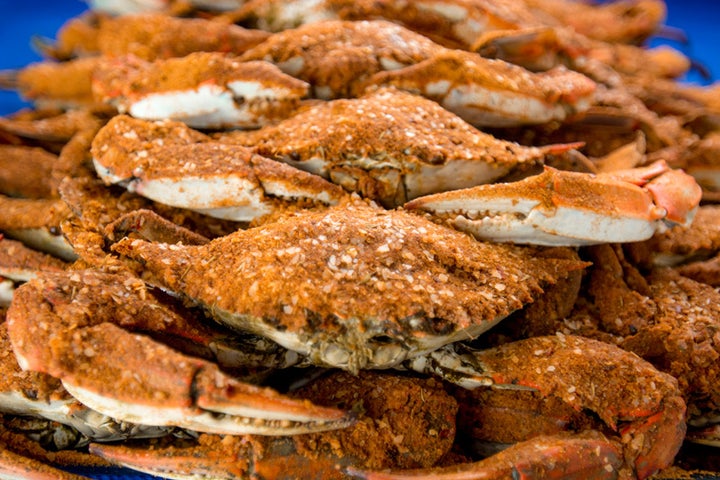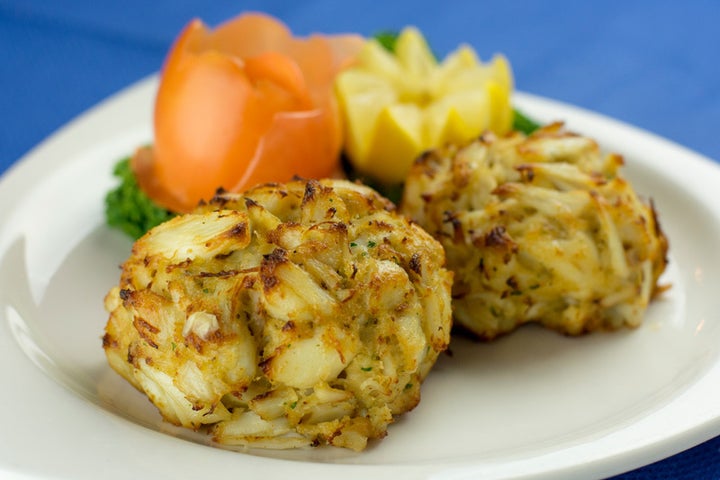
Oh, are we blessed in the U.S. of A. with wonderful crab-eating possibilities! Our country is literally surrounded by gorgeous crustaceans.
However, in the midst of all this glory we who care about our crabs have a few serious disagreements.
Which species of crab available in American waters is the best? What’s the best region for that species? What’s the best way to prepare and eat our glorious crabs?
There are 850 crab species in the world, but just a few are commonly harvested in the U.S. In weighing the superiority of those American crab species, there are a few nagging problems for purists. In some cases, the problem is distance and the remoteness of the crabbing grounds. Both the species of snow crab and the king crab, a marketing name that actually encompasses three similar species, are caught primarily in Alaska, which means the meat typically comes to us on the mainland frozen. It isn’t bad, but some crab lovers want fresh, for all kinds of texture and flavor reasons.
Some crab-lovers also want whole crab, so they can have the delight of picking it apart, of finding all its secret sections. That’s another strike against snow and king crab — their frozen meat comes in the form of legs, and the rush of wholeness and freshness just ain’t there in these separated extremities.
Another species is the stone crab, most famously caught and enjoyed in Florida. There’s no doubt about the separated extremities here: Only the black-tipped claws ever come to market. Throughout the winter, diners enjoy the claws of Florida stone crabs across the country, usually dipped in a creamy mustard sauce, but is the crab itself among the best? Not in my opinion. Its taste is a little watery, not super-intense, and its texture is a little stringy.
Then there’s the Jonah crab, which is native to New England. This one will never be a prize-winner. Its meat is just fine for blending with other things in sauces, fillings and salads, but as a stand-alone, it’s not a contender.
So that leaves the two heavyweight species of American crabbery, the Dungeness crab and the blue crab.
Dungeness crab is harvested up and down the Pacific Coast but is named for a crab-industry town on the Olympic Peninsula in Washington state. Dungeness is pleasing to many people, especially those who love picking apart a whole crab. Its great advantage compared to the East Coast blue crab is its size, usually spanning 6 to 9 inches across. Because of the size of Dungeness crabs, pickers can extract large lumps of meat even from the body, and this meat is good — sweet, succulent, quite crabby.
Even with the extra pickin’ involved, I’ll take a blue crab any day. I’ve no doubt that this is our country’s greatest species and a contender for top species in the world. The meat is superior in every way: crabbier, sweeter, and a good blue crab has a delicious fatty quality that’s hard to find elsewhere. If you’re really into the pickin’ thang, the roe of a female blue crab, bright orange when cooked, is wonderful, and the sweet, fatty tomalley is a gourmand’s delight. Around Maryland, they call this greenish-yellow goop “the mustard.” Even the blue crab’s Latin species name is special — callinectes sapidus, “beautiful savory swimmer.”
Finding the best
Now that I’ve unilaterally declared the blue crab America’s best crab species, let’s look at where you want to eat blue crabs. It’s in Maryland, or anywhere near the Chesapeake Bay.
Blue crabs can be found all along the eastern seaboard, from Maine downward, even into the Gulf of Mexico and as far south as Uruguay, but people who know the subject always tilt toward the ones from the Chesapeake Bay, which, thanks to a recent clean-up, now holds over 700 million crabs! If you seek the Chesapeake blue, there’s a “peak season” — September and October — and they’re hard to find outside of that.
“Sure, we serve local crabs in late summer, early fall,” says Nick Triantafilos, whose family started Costas Inn in a Baltimore suburb in 1971. “But for most of the year, we’re selling crabs from further south, and into the Gulf.”
I listen carefully to Nick, co-manager with his brother Peter, because Costas Inn is my favorite crabhouse in Maryland, which means in the world. Nick agrees with the legend of the Chesapeake blue crab.
“No doubt that a September/October blue crab from the Chesapeake Bay is the best crab you can find. The sweetness is remarkable. And at that time of year, they’ve begun to dig in for the winter, which means they’re storing fat for the cold days ahead,” he says.
However, “people shouldn’t underestimate Gulf crabs. In fact, unless you’re an expert, you may not be able to tell them apart from Chesapeake crabs in a blind tasting, except for one thing — size. Gulf crabs are usually larger, which is a good thing!”

Let’s eat
To a Baltimorean, the ultimate feast is a pile of whole crabs, steamed, tossed on huge sheets of brown paper at the table. Intriguingly, other great crab places up and down the seaboard and on into New Orleans prefer to do a crab “boil,” but the Chesapeake crab fanatic feels that boiling drives too much water into the meat. They like it “juicy,” not “wet,” which they think steaming achieves.
There’s another factor. The classic crab boil involves spices, as does the Maryland Steamed Crab, but in Maryland the spices — usually a blend like Old Bay, though many crabhouses make their own blends — are applied only to the shells of the crab. In the rest of the American crab-pickin’ world, spices go into the boil, which means they mingle with the meat itself. Oh, there’s plenty of spice in Maryland, but for god’s sake keep it off the crab meat!
“We do find, however,” says Nick Triantafilos, “that many visitors are intimidated by picking apart whole crabs and that’s why crab cakes became so popular, even among locals. In fact, I’d have to say that the crab cake is undoubtedly the iconic dish of the state of Maryland.”
We at Flavored Nation agree, and that’s why we’re bringing Nick’s brother Pete out to St. Louis to make crab cakes at our event from Oct. 27 to 29.
“What makes a great crab cake?” I ask.
“One thing above all,” says Nick, “Fresh crab. The fresher the better. We use some excellent refrigerated tins of jumbo lump crab meat in our crab cakes, and only jumbo lump, but whenever possible we like to pick the just-steamed crabs ourselves, insuring that the meat is even fresher.”
A crab cake also needs binding, usually done with mayonnaise, eggs and a little bread crumb, as it is done at Costas. “The less the better,” says Nick.
Lastly, there’s the cooking method. “Pan-frying is the traditional method,” Nick says. “In the old days they used lard. In modern times, people like us use vegetable oil, but believe it or not only about 10 percent of our crab cakes are pan-fried. We give the customer the choice, pan-fried or broiled. Probably because of everyone’s health mania these days 90 percent of customers ask for broiled crab cakes.”
“Myself,” Nick continues, “I prefer a pan-fried crab cake. That extra browned taste on the outside is extraordinary, especially in late summer/early fall when our local crab meat has the intense flavor to stand up to the crackling brown crust.”